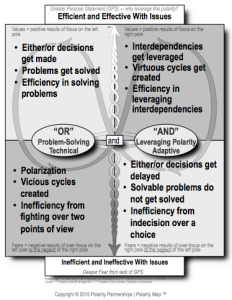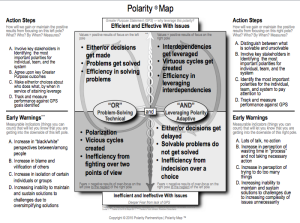The Critical Competency for the 21st Century Leaders:
Solving What’s Solvable and Leveraging What’s Not
When a leader, team, or organizational system is facing a change, conflict, chronic issue, or cross-cultural challenge, one a question that has potential to create outsized results is:
“Is this challenge solvable sustainably by choosing either one or the other in this tension?”
A half-century of focus and research has made it clear that some challenges aren’t solvable to begin with. So, it’s a most rational question that may be more rational the earlier in the process that it’s asked.
In 1967, C. West Churchman highlighted some key factors of unsolvable challenges he referred to as “Wicked Problems.” They are:
1) Unsolvable by rational analysis,
2) Systems issues, and
3) Require collective engagement for learning the way to solutions.
Another important voice in the solvability discernment arena is Ron Heifetz who made the clear distinction between “Technical” problems (which are solvable) and “Adaptive” problems (unsolvable). Like Churchman, he also highlights the need for using the collective intelligence of people at all levels to learn their way toward solutions. Heifetz discusses how traditional management strategies are useful in dealing with technical problems, but in situations where beliefs and values come into play technical “fixes” tend to exacerbate the problem. While the “distinction is a crucial one,” he says, “leadership theory has only begun to address the latter.” (In his book Good to Great, Jim Collins refers to this as, “the Tyranny of ‘OR’” and highlights the importance of seeing when to tap into, “the Genius of the ‘AND.’”)
Starting in 1975, Dr. Barry Johnson identified the need to supplement problem solving thinking (using “either/or”) with polarity thinking (using “both/and”). The evolution of his key principles and Polarity MapÔ has resulted in a powerful approach to accelerate collective engagement and learning. Performance is measured in real-time for multiple polarities, for multiple purposes, and at multiple system levels simultaneously (organization, team, and individual levels). The inherent tension is used as a resource to create sustainable competitive advantage referred to as “leveraging,” which is superior to false-choice trade-offs and even to “balancing,” which is considered a sub-optimal goal or measurement outcome.
The business literature has referred to these chronic unsolvable challenges by other names, such as: Ambidexterity, Competing Values, Contradictions, Dichotomies, Dilemmas, Dualities, Dual Operating Systems, Dual Strategy Cultures, Hybridity, Paradoxes, Tensions, Theory X and Y, and Opposite Strengths – to name a few. In their review, Smith and Lewis (2011) found that in organizational theory, paradox studies have grown, on average, 10% annually between 1998 and 2008.
[1]. The following three quotes summarize this body of research:
“I believe the central leadership attribute is the ability to manage polarity.”
Peter Koestenbaum
Leadership, New and Revised: The Inner Side of Greatness, A Philosophy for Leaders
“If your organization strategy does not account for polarity, then it is not strategic.”
Bob DeWitt and Ron Meyer
Strategy Synthesis
“The test of a first rate intelligence is the ability to hold two truths in mind at the same time, and still retain the ability to function.”
F. Scott Fitzgerald
The June 2014 Journal of Applied Behavioral Science included an article entitled, “Paradox as Metatheoretical Perspective: Sharpening the Focus and Widening the Scope.” One of the conclusions was to,
“…encourage practitioners to reframe tensions from either/or to both/and, while identifying strategies for engaging and living with paradoxical tensions.”
As recognition of the value of “both/and” thinking is increasingly recognized, one thing to be aware of is to resist the seductive temptation to advocate going from an “either/or” thinking to “both/and” thinking as a solution to the tension between the two needs. It is true that the overemphasis on “either/or” thinking has created severe problems. However, going From “either/or” thinking To “both/and” thinking implies (though perhaps it’s not stated explicitly), that it’s necessary to leave “either/or” thinking behind in favor of “both/and” thinking – as the preferred solution. As helpful as this may be as a needed and necessary self-correction, the same dynamics of polarity thinking will apply to the thinking polarity between “either/or” thinking AND “both/and” thinking. In other words, advocating for “both/and” thinking as a solution will generate its own resistance to the move. The resistance will come from those who have a legitimate value appreciation for maintaining the benefits of “either/or” thinking. They’re concern will be focus on the negative consequences (downside limitations) that could result from an over-focus on “both/and” thinking, which is legitimate. Therefore, we can frame the need for the shift without advocating for the shift as a solution this way:
“…To be efficient and effective with important issues, we need to shift From ‘either/or’ thinking alone To leveraging the benefits of BOTH ‘either/or’ thinking AND ‘both/and’ thinking together.”
Like inhaling and exhaling in breathing, 21st Century leaders need to leverage these two interdependent thinking competencies as a pair. The first step in the process is to make the important distinction between what is solvable and what’s not. The central portion of the Polarity Map, below, illustrates this chronic, ongoing, unsolvable – but leverage-able – tension:
Below are a few (of many) unsolvable (polarity) challenges:
Leaders:
Grounded AND Visionary
Planning AND Execution
Directive and Participative
Self-assured AND Humble
Candor/Honesty AND Diplomacy/Tact
Logic AND Emotion
Teams:
Production (task) AND People (relationships)
Focus on Individuals AND Focus on the Team
Focus on the Team AND Focus on the Organization
Focus on the Team AND Focus on the Customer
Hold Responsible AND Provide Freedom
Accountability AND Support
Organization Systems:
Continuity/Stability AND Transformation/Change
Margin AND Mission
Short-term success AND Long-term success
Cost AND Quality
External Focus/Market AND Internal Focus/Culture
Employee Focus AND Organization Focus
Organization Focus AND Community Focus
Organization Focus AND Environmental Focus
“Either/or” problem solving thinking can be used to prioritize among the most important of the tensions, identify key stakeholders necessary to build a complete Polarity MapÔ, and determine what the best Action Steps and Early Warnings are to create leverage in those tensions. This is efficient “either/or” problem-solving in the service of leveraging the key polarities. Some Action Steps and Early Warning Signs in Polarity Map below demonstrate how to maximize the benefits of both types of thinking, while minimizing the downside limitations of over-emphasizing either type of thinking to the neglect of the other.
As Albert Einstein famously said,
“We cannot solve our problems using the same thinking we used when we created them.”
When “no” is the answer to, “Is this challenge solvable sustainably by choosing either one or the other in this tension?” — it’s time to apply the right thinking approach and tool/s for the “both/and” job.
I’m ready when you are. We stand ready at Polarity Partnerships, too.
PRINTABLE .PDF
PM_Blog_Distinction_1
[1] Smith, W. K., Lewis, M. W., & Tushman, M. L. 2011. Organizational sustainability: Organization design and senior leadership to enable strategic paradox. In K. Cameron, & G. Spreitzer (Eds.), The oxford handbook of positive organizational scholarship: 798-810. New York, NY: Oxford University Press.






